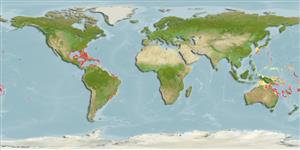Common names from other countries
Teleostei (teleosts) >
Scombriformes (Mackerels) >
Trichiuridae (Cutlassfishes) > Lepidopodinae
Etymology: Evoxymetopon: Greek, eu = good + Greek, oxys = sharpen + Greek, metopon = brow (Ref. 45335).
More on author: Gill.
Environment: milieu / climate zone / depth range / distribution range
Ecology
Marine; benthopelagic; depth range ? - 200 m (Ref. 13628), usually 100 - 200 m (Ref. 13628). Deep-water; 35°N - 29°S, 126°E - 39°W (Ref. 6181)
Western Atlantic: Bahamas, Caribbean Sea, and off southern Brazil (specimens found at the Institut für Seefischerei, Universität Hamburg collected from 24°40'S, 44°35'W). Northwest Pacific: Cheju Do Island, south of Korean Peninsula.
Size / Weight / Age
Maturity: Lm ? range ? - ? cm
Max length : 200 cm SL male/unsexed; (Ref. 6181); common length : 155 cm SL male/unsexed; (Ref. 6181); max. published weight: 1.7 kg (Ref. 5217)
Dorsal soft rays (total): 81 - 90; Anal spines: 0; Anal soft rays: 60. Lateral line fairly straight, running mid laterally or slightly nearer the ventral contour than the dorsal contour. First anal fin ray scale-like, others ordinal and short. Pelvic fins reduced to a scale-like process spine. Body silvery white with slight red-brownish on dorsal part; several longitudinal pale yellow stripes on body.
Occurs on the continental slope and sometimes the continental shelf.
Life cycle and mating behavior
Maturities | Reproduction | Spawnings | Egg(s) | Fecundities | Larvae
Nakamura, I. and N.V. Parin, 1993. FAO Species Catalogue. Vol. 15. Snake mackerels and cutlassfishes of the world (families Gempylidae and Trichiuridae). An annotated and illustrated catalogue of the snake mackerels, snoeks, escolars, gemfishes, sackfishes, domine, oilfish, cutlassfishes,. scabbardfishes, hairtails, and frostfishes known to date. FAO Fish. Synop. 125(15):136 p. (Ref. 6181)
IUCN Red List Status (Ref. 130435)
CITES (Ref. 128078)
Not Evaluated
Threat to humans
Harmless
Human uses
Fisheries: subsistence fisheries
Tools
Special reports
Download XML
Internet sources
Estimates based on models
Preferred temperature (Ref.
115969): 16.1 - 23.6, mean 19.5 (based on 75 cells).
Phylogenetic diversity index (Ref.
82804): PD
50 = 0.5625 [Uniqueness, from 0.5 = low to 2.0 = high].
Bayesian length-weight: a=0.00214 (0.00094 - 0.00484), b=2.99 (2.78 - 3.20), in cm Total Length, based on LWR estimates for this species & (Sub)family-body (Ref.
93245).
Trophic level (Ref.
69278): 4.5 ±0.7 se; based on size and trophs of closest relatives
Resilience (Ref.
120179): Low, minimum population doubling time 4.5 - 14 years (Preliminary K or Fecundity.).
Fishing Vulnerability (Ref.
59153): Very high vulnerability (90 of 100).
